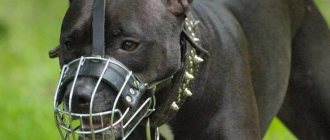- 24.01.2020
Dogs are intelligent animals capable of expressing their emotions and desires. You need to talk to her, like any family member, try to understand her condition and behave in accordance with it.
Dog handlers recommend quickly noticing how the pet reacts to the movements of the people around it: some unintentional actions can be interpreted by the dog as a very clear statement or desire. For example, if you take your eyes and hands away from your dog at the same time while making eye contact, the animal may think that you are no longer going to approach him and communicate. It is also worth studying the pet’s reaction to yawning: some see it as a negative emotion and believe that the person is upset.
Other movements made by the owner can cause discomfort in the dog, these include:
- The dog considers a long and intent gaze into the eyes to be a threat.
- An aggressive reaction to signs of intimidation and discomfort will subsequently affect the animal’s psyche: it will become afraid even more often.
- As soon as the pet has crossed the threshold of the house, it should be accustomed to tactile contacts, since many animals do not like patting the head or hugs. Such proximity is regarded as an attack.
- Active gestures and communication in raised voices will upset insecure and fearful dogs. It is not recommended to scold a pet using such methods: it will not understand the reasons for aggression on the part of the owner and will continue to behave as before. You need to communicate with the dog kindly and calmly.
Training is a useful tool for establishing contacts with a companion. The dog will be able to understand the owner’s needs more clearly and get rid of unwanted behavior, making it easier to continue living with people. The commands are pronounced in a clear and measured voice; if the request is successfully completed, the animal must be encouraged, showing joyful satisfaction with the tone of the voice and facial expressions.
Dog tongue: types of signals
The system of signs and behavior developed by dogs aimed at communicating and avoiding conflicts is called the calming signal system. Sometimes, when we are angry, it may seem that the dog is not listening to us or is deliberately resisting commands. This is not true, and interpreting these signals as conscious opposition is a mistake people often make.
Dogs, through some of their signals, try to calm the owner, but he, not understanding this, becomes even more nervous. Therefore, you should know in what ways the pet will try to avoid the owner’s anger and calm him down. Although the entire group of these signs are called calming signals, there are other signals among them:
- threatening;
- inviting to the game;
- stressful.
To read them correctly, you need to closely monitor the dog.
Birds are domestic and not so
Owners of feathered pets know for sure how the bird requires food, walks around the perimeter of the room, or communication. But poultry still have many signals in reserve, in addition to these.
For example, if a parrot sits on one leg, yawns, stretches and looks at you with his head bowed, it means he wants to please you. In communication with birds, the eyes play an important role - the pupil narrows, turning the gaze into a “snake” if the bird is aggressive. When the bird is calm, the pupil is practically invisible.
Another form of manipulation on the part of birds is aggressive begging, which is inherent in flocks of street birds that surround you, looking into your eyes, or even completely take away your tasty morsel on the fly. No matter how we try to classify the methods of manipulation by animals, it will always be quite simple to control a person, and this is the result not so much of intelligence and cunning as of external charm and deceptive childish defenselessness.
Stress signals
The most common sedative signals used by dogs are:
- Turning your head is an attempt to calm down in a stressful situation;
- U-turn – calming down when feeling nervous;
- Freezing in immobility, slow movement is an attempt to calm the owner, and this behavior is often confused with the dog’s disobedience, for example, when trying to call the dog in an angry voice;
- Lying on his stomach is an encouraging behavior; a dominant dog encourages the approach of another animal that is afraid of him;
- Yawning is a calming behavior in a stressful situation;
- Licking is a greeting ritual and a calming signal. This is an infantile behavior, common in puppies and in submissive, dominant or fearful dogs, and its purpose is to avoid aggression;
- Physical intervention in conflict - a dog, suspecting an intention to fight between two individuals (humans or dogs), tries to prevent this by separating them with its own body.
In addition, you should pay attention to such behavior as:
- looking to the side;
- squinting;
- licking;
- dyspnea;
- raising one paw;
- falling to the ground;
- sitting;
- chills;
- urinating under oneself (this can also be a signal of submission and joy);
- falling on your back and exposing your stomach;
- immobility, pretending to be dead;
- sniffing;
- whining.
Skillful capture of these signals allows timely intervention, but ignoring these signals or misinterpreting them leads to the next stage of the dog's behavior in relation to aggression, i.e. preventive behavior.
What do tail movements mean?
Important aspects of a dog's body language are the movements performed by different parts of the body. The most obvious organ for reading a dog's behavior is its tail. Contrary to popular belief, not all of his movements are signs of joy and friendly gestures. Depending on the manner and intensity of movements, they express a number of other feelings.
An important factor when reading dogs' tail signals is the frequency of the beats, location, and a number of other details.
Movements performed with energy indicate purpose and excitement. The more intense the movement, the more involved the dog is. The more the tail is motionless, the greater the dog's reluctance to participate in a particular situation, this indicates avoidance and anger.
The main signals that a dog sends with its tail:
- Lowered tail, relaxed movements - a friendly attitude, satisfaction, interest and relaxation of the dog;
- A raised tail signifies confidence (also aggression), excitement or excitement.
- Intense movements, including croup - submission and friendly submission, an attempt to win favor
- The tail is hard, hanging along the line of the back, slow movements - anger;
- Loose tail, rigid movements - anxiety, nervousness, desire to win the favor of another individual;
- The tail is lowered low, pressed between the hind legs - fear, uncertainty;
- Tail 45 degrees below the back line or slightly higher – interest and alertness.
An interesting fact: the dog’s tail bends slightly to the left when it sees its owner, and to the right when it sees another animal - the differences, however, are almost imperceptible.
What does a dog's gaze say?
Normally, dogs' eyes are calm, the eyelids are loose and soft, and the whites are invisible, with the exception of some breeds. In this state, the dog feels pleasure, submission, and relaxation.
Other signals:
- Turns away, lowers his eyes - this is uncertainty, or an attempt to show something. Does not mean guilt;
- The manifestation of proteins is fear, or an attempt to look at a given object without turning your head towards it, a sign of “I need space”;
- Squinting is an attempt to reassure an opponent by expressing uncertainty or fear;
- Eyelids are very dilated - panic or aggression;
- Eyes wide open - excitement, aggression, anger;
- Looking eye to eye is a threat, a call to fight.
In dogs, vision is used to regulate the issue of leadership in the herd, which also affects relationships with humans. The gaze between two individuals is maintained until one of them averts it and lowers its head, or intensifies the threats directed at the other or launches an attack. Therefore, maintaining eye contact with a dog that is nervous, excited or tense may provoke him to attack because it is perceived as provocation to the animal.
Gentle eye contact, however, can strengthen the relationship between human and dog.
Snezhana Yakushkova is a dog handler and zoopsychologist, an employee of Petro. Engaged in the selection and training of therapy dogs to work with children. She told the Petrozavodsk Speaks portal how to behave with unfamiliar dogs, whether it is difficult to understand a dog’s “language” and when you can look a dog in the eyes.
“They say about dogs: “He understands everything, he just can’t say it.” Is it really?
- More likely no than yes. The dog really reads us better than we sometimes understand it. This is one of the ways dogs survive as a species.
They are able to grasp a person’s mood and predict his intentions. In addition, these animals are selfish and subtle manipulators. You should always remember this. Owners know how a dog can demand, for example, to get a ball or cover it with a blanket, if it is accustomed to this. So dogs are able to “tell” a person what is necessary.
And the fact that a dog “understands everything” is rather a beautiful myth. Of course, they show a stronger attachment to people than other pets, but not everything is so simple. They are capable of manipulating their owners and even showing aggression towards family members.
—Can a dog understand human speech?
- Definitely not, no matter how much I would like to believe it. Try, for example, instead of using the command “sit”, use any other word, for example “boot”. You can also develop the dog’s reaction to sit on it. If you accompany the command with a gesture, the dog will sit down regardless of what word you say. When a dog in a circus shows a certain letter, or barks five times in response to “two plus three,” this is just the trainer teaching it to perform the necessary actions in response to a certain gesture. Of course, the animal can distinguish some familiar words, but if a service dog was trained, for example, in Germany, in the German language, it is brought here - and here it adapts very quickly and can immediately work. There is practically no need to use German words, if only at first.
- What is the best way to communicate with a dog - with words or gestures?
- It all depends on the situation. If this is my pet, and I, for example, watch TV, I can say: “Look, dog, see what cats are like,” that is, this is simply how I maintain contact with the animal. And it’s a completely different situation if my dog wants to fight with the neighbor’s. Here words are inappropriate; moreover, they can further inflame the conflict. Or if a dog is afraid of something, it is useless to persuade it. Also, you can’t “explain the situation” to her: “Wait fifteen to twenty minutes, and I’ll take a walk with you, but I need to change clothes.” But the dog just couldn’t bear it. You can try to look at the animal world - do they communicate with words? No - only gestures, “speaking” poses (submission, aggressiveness, friendliness, etc.) and various sounds - barking, howling, growling and others.
The rule of behavior with unfamiliar animals is “do not look, do not touch, do not talk.” Sometimes I come to visit someone and the owners are surprised that this is the first time their cats have come out to a stranger. And it’s very simple - I don’t violate their personal boundaries.
Some dogs have a habit of vigorously greeting any visitor by jumping and licking. Usually I just don’t pay attention to such loving dogs - I calmly start undressing and walk on by. If an animal behaves too intrusively, rubbing its nose into my things, I can lightly poke it in the side with my fingers, showing that this is my territory and I do not like this behavior. For dogs, such boundaries are important.
— What signals does a dog give to a person to show that something is bothering him?
— Let's say there is a problem of dogs biting people. But before he bites, the dog demonstrates a lot with its behavior. She says with all her appearance: “Don’t touch me - I’m worried.” Because this is how the nature of a dog works - not to immediately rush into an attack and kill. Before starting a fight, dogs demonstrate certain postures; they have a whole ritual. And if people don’t interfere, they usually disperse peacefully. Of course, some dogs exhibit behavioral disorders when they show unmotivated aggression, but this is very rare.
- Can a dog show that something hurts?
- Yes, maybe you just need to be attentive to her behavior and postures. A healthy, calm dog can, for example, lie on its back, spread its paws, open its belly - its most vulnerable place. If something hurts, she, on the contrary, will close down and react painfully to touch. Although there are more difficult situations with some breeds. I know a real story where a six-year-old Stafford dog ate a rope while out for a walk, and for two weeks showed no pain, and when the problem appeared, it was too late - the dog had to be put down.
— Can you “agree” only with your dog or with any dog?
— I recently saw a wonderful video online about why you shouldn’t tie your dog near stores (I’m also against this). There was a bull terrier, a stafford, a husky, and a mongrel - about ten different dogs. The owners were shown tying them up and leaving. Then a stranger appears, gains confidence in the dog, unties it and takes it away. So the specialist can “agree” with other people’s dogs.
— The Ministry of Emergency Situations recently published tips on how to scare away an aggressive dog: you need to stop and in a firm voice give the commands “fu!”, “place!”, “stand,” “sit!” Will it work? And what if the dog is stray or does not know commands?
- It all depends on the situation. This will only work if you are completely confident in yourself. Let's say there are fifteen dogs in front of you. You have identified the leader, make eye contact with him and strictly say “no.” If you morally defeat this leader, yes, they will leave. But if dogs attacked a child, all these “fu”, “stand”, “lie” from his mouth will not work.
Of course, there are also children who can train a tiger - it’s in them. But usually children and old people are weak people both physically and spiritually, and animals read this. In nature, who is hunted by a tiger, a lion or a wolf? These are either wounded animals, or young and old weakened individuals.
So the first tip for dog attacks is to not argue and get around. Because when you give such a challenge, you need to be sure that you can handle the situation.
— Is it possible to use a stick or an umbrella to defend against stray dogs, as the Ministry of Emergency Situations advises?
— Of course, even a backpack or a bicycle, which you can use to create a barrier between yourself and the dogs. In this case, you need to take care of protecting your back, for example, move back to the wall. Because dogs hunt like wolves - one distracts, others attack from behind. You can divert the attention of an aggressive dog to your bag or backpack. She will grab it and tear it, in full confidence that she is tearing you apart.
And at this moment you must have a cold mind - during this time you need to calculate the escape routes. That is, it is possible and necessary to switch her attention. And an umbrella can actually work amazingly well with some dogs. If you open it, they are even amazed - there was a man and there is no man. This is explained by the peculiarities of the dog’s perception - it does not understand that it is an umbrella, it just suddenly sees some kind of spot in front of it. You can also play on psychology - raise your hand or backpack to “become bigger.”
— How should you behave so as not to provoke the dog into aggression?
- If the dog’s posture shows fear, wariness (hunched back, tucked tail, flattened ears) - of course, you should not pet it. With an unfamiliar dog, remember the “do not look, do not touch, do not talk” rule. You can pet the dog only after it has relaxed - does not jump on you, does not demand that you play with it. You need to understand that even a dog's tail wagging does not always mean a greeting. When a dog is bullied, or it sees its enemy, it is excited and also wags its tail; when it mouses (hunts), it will have a different tail swing.
— Is it true that you should not look into the eyes of a strange dog, because direct gaze is perceived by the animal as a challenge?
- Looking into the eyes demonstrates self-confidence, this is how a dominant individual, the leader of the pack, behaves. Therefore, if you are confident in yourself, this can prevent the animal from attacking. If the dog does not show obvious aggression, but behaves warily, it is better not to make eye contact with it - this will help prevent a conflict. Also, you should not “pressure with your gaze” on timid dogs. If you have a chained dog in front of you who is guarding his territory, the best tactic is to walk calmly past, showing neither fear nor aggression and pretending that you are not paying attention to him.
What does the facial expression say?
The standard facial expression of a relaxed dog is that the cheeks hang freely and the mouth is slightly blunt or closed (but not pinched).
- Open mouth, teeth exposed in a wide grimace - submission;
- The lips are tense, the skin on the nose is wrinkled, the incisors and fangs are exposed - indicate aggression, self-confidence and readiness to attack at the slightest provocation;
- The cheeks are pulled back, all the teeth are exposed, the dog growls - aggression caused by fear or protection, for example, of food;
- Yawning - if not due to fatigue, it means stress and nervousness, sometimes also a sign used when the animal is impatient
- Shortness of breath - if it is not the result of fatigue or overheating, it means stress;
- Licking your cheeks or nose is generally a sign of stress. If a dog licks its teeth shown in a threat, it indicates that it is threatening out of fear;
- Wagging its muzzle is an attempt to attract attention or an attempt to test a new, unknown smell.
Wild relatives
After putting the information together, the experimenter went to Pretoria to repeat the experiment with real wild cats at the local South African zoo.
Michael has made several recordings of wild cats, believed to be the immediate ancestors of domestic pets. Interim results showed that the low “voices” and “words” of wild cats are not only not perceived by people as phrases of a certain tone, but often do not even allow them to identify the animal emitting them.
The scientist concluded that over the years of evolution and cohabitation with humans, cats simply developed a language based on the human range and psychology, which is understandable to humans and provokes a response. He is echoed by scientists from the University of Sussex, who conducted experiments under the leadership of Dr. Karen McComb, who argue that the pleading purr of a cat is very similar in the range of sounds to the crying of a child, so we subconsciously strive to give up everything and please the wishes of our pet.
Dog body language: posture
The head is raised high, the ears are erect, the dog is looking straight ahead, the chest is up, the withers are raised, the legs are wide, firmly planted in the ground, the tail is raised up.
The dog tries to appear bigger. Can growl and slowly move its tail - a confident dog showing its dominance.
The head is lowered, the legs are bent, the tail is pointed down, the dog turns its head, cowers, and tries to move as little as possible.
She approaches the other person from the side, taking the minimum possible pose. The tail is located below the line of the back, she can swing it. It can also lick the face of another dog or the hands of a person, and often lick its own nose. An animal that is unsure of itself, afraid or showing subordination to a stronger individual, giving up.
If the dog understands that the above behavior does not cause the opponent to soften, then he lies on his back, exposing the most sensitive parts of the body. A dog lying on its back, with its paws raised and its belly exposed - complete submission, giving its life to a person or another dog.
Other signals:
- The dog raises one paw, bent at the wrist joint - shows tension or fear.
- The paw is vertical, the dog lies on its front paws, holding the croup up, vigorously wagging its tail - this gesture means encouragement to play.
- Positioning transversely to another individual is a signal indicating that the dog is not looking for conflict, but is not showing submission. She wants to maintain a state of balance.
No less important means of expressing your pet’s mood are sounds and smells.
What does a dog say with its voice?
Dogs make a number of different sounds to express their emotions. A low tone means threat, anger, and a high tone means a friendly attitude. The longer the sound, the more likely it is that the dog is using it on purpose and letting you know about upcoming behavior. The speed and frequency of the repeated sounds are also important: the higher they are, the greater the degree of stimulation they indicate.
- Barking.
This is a signal aimed at warning the herd (strong, medium tone), but also signifying the joy of the owner's return (one or two barks in a high key), an invitation to play (a series of barks, starting in a medium tone and going high), searching for a scent, irritation (one sharp bark in a low tone), anxiety, etc. - Howl
. It is used to mark one’s territory, to keep other individuals from violating it, or, on the contrary, to call. A dog left alone also uses this signal to call its owner. - Sobbing or squeaking
. Given to puppies and adult dogs to convey discomfort, pain or impatience. - Growl. Warning signal (quiet, low tone, coming from the chest). If the signal is associated with a feeling of uncertainty and fear, then it passes in a higher tone and the sound comes out of the mouth. A dog that is confident in its superiority does not growl.
Sound manipulation
Nicholas Nicastro, a psychology student at Cornell University and an assistant to Professor Michael Ouren, conducted several experiments in the voice and sound psychology lab.
In his opinion, domestic cats use a wider range of sounds to communicate with humans, unlike their fellow tribesmen. Having collected a photo library of 12 cats (two of them were the experimenter’s own pets), Michael concluded that this range ranges from 12 to 1520 Hz.
The second part of the experiment involved 54 people who were asked to classify sounds according to the degree of satisfaction and, conversely, dissatisfaction and aggressiveness. The participants in the experiment were guided by their own feelings, and most of them had never been cat people.
It turned out that cats emit incredibly familiar-sounding “phrases”, clearly differentiating the tonality with which to warn a person about their reluctance to communicate or, on the contrary, to demand attention.
What not to do with a dog - prohibited signs
- We cannot allow a dog to feel power over us.
- You should not kiss a dog on the face under any circumstances - this is the behavior of a puppy showing submission to the bitch and older dogs, and can be read as a submissive gesture of the owner.
- It is forbidden to let the dog pass first when passing through the door. The dog must follow the owner.
- It is forbidden to allow a dog to sit in the owner's place without his permission.
- You need to look down on the dog, always stand above it, so that it knows that the person is the leader.
Cats
“Nothing has changed since Ancient Egypt. People write on walls and love cats.” This joke never loses its relevance. Cats were worshiped, feared, revered as kings and hated as evil spirits.
Cats have more power over us than might seem at first glance. The cat will not caress just like that, it is enough for her to communicate with her fellow tribesmen and a plush mouse, but if she needs something, then the sad look of the puss in boots from the famous cartoon will not be limited to.
A group of behaviorists from the University of Vienna found that the greatest mutual understanding is established between young active cats and extroverted women. Dorothy Gracie, one of the authors of the experiment, claims that cats establish a strong social connection with us, and in relationships with people they behave like children - they carefully demand, hint and even be capricious.











